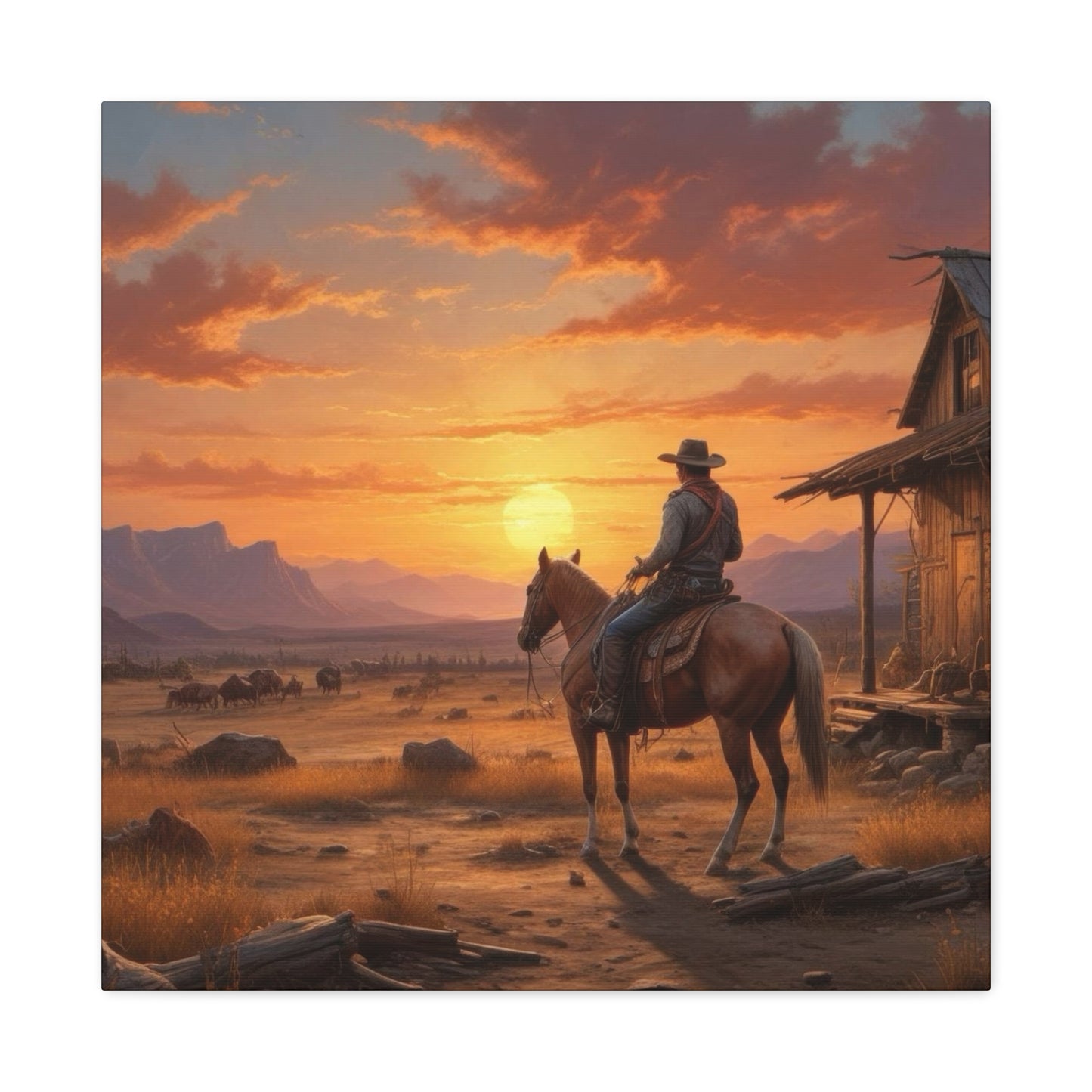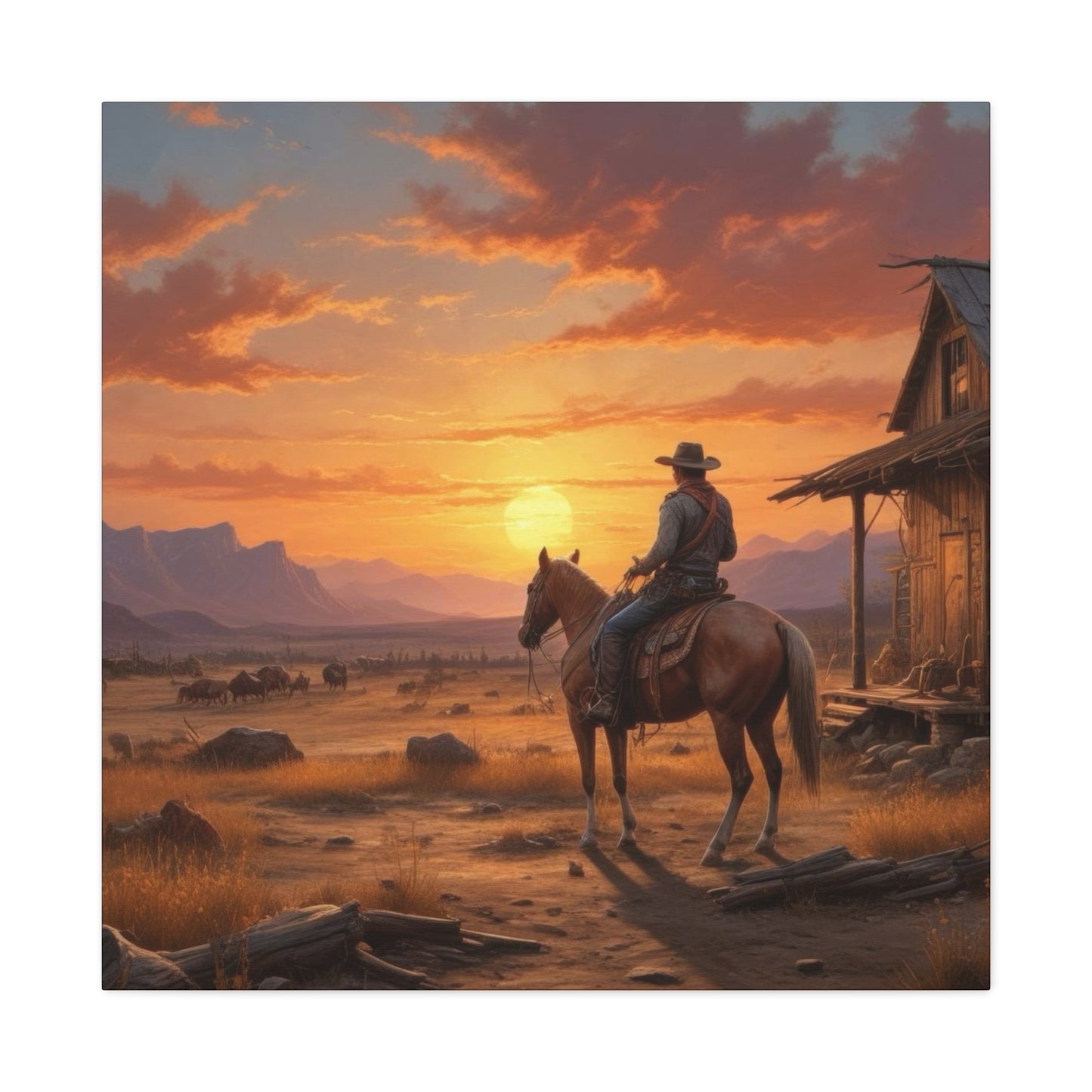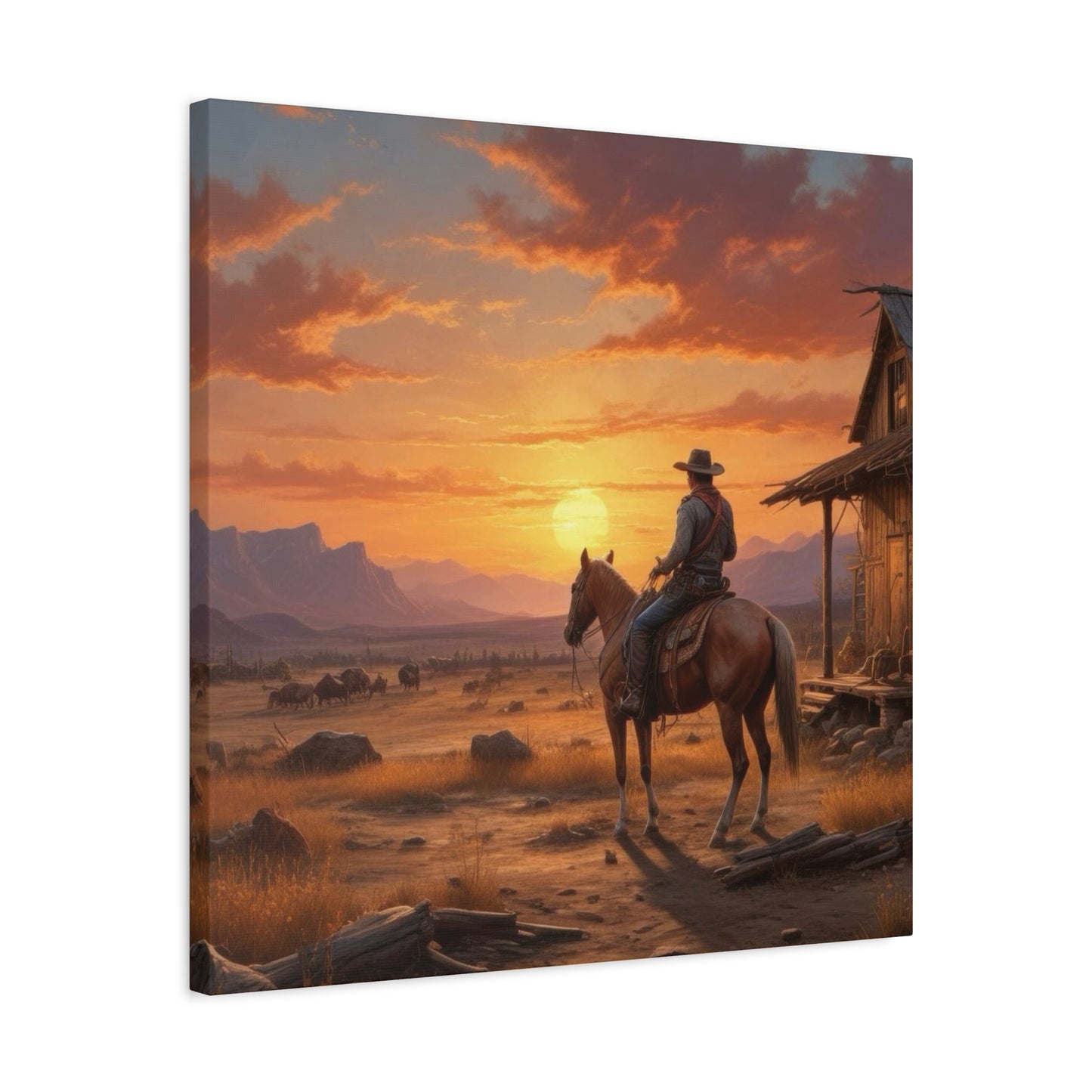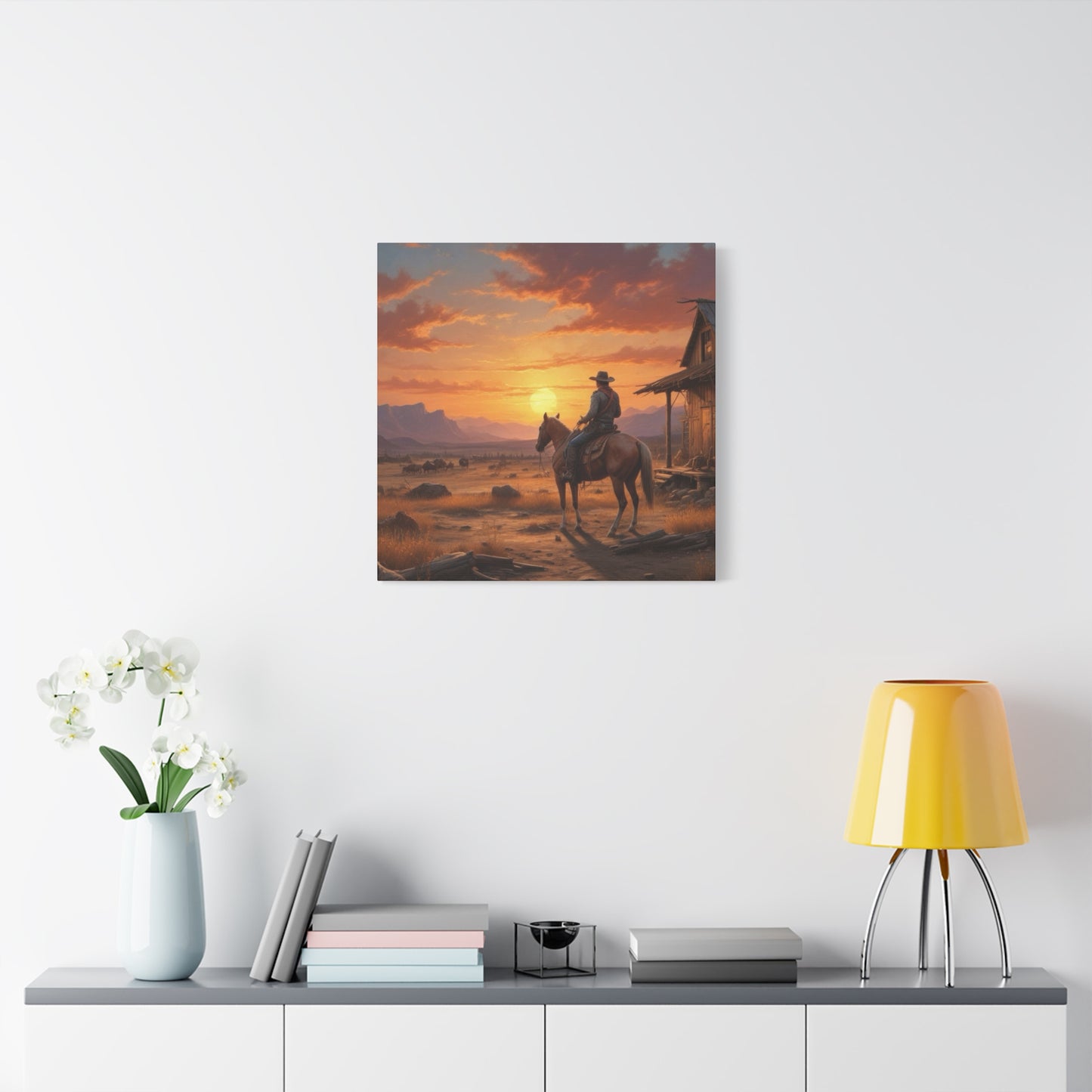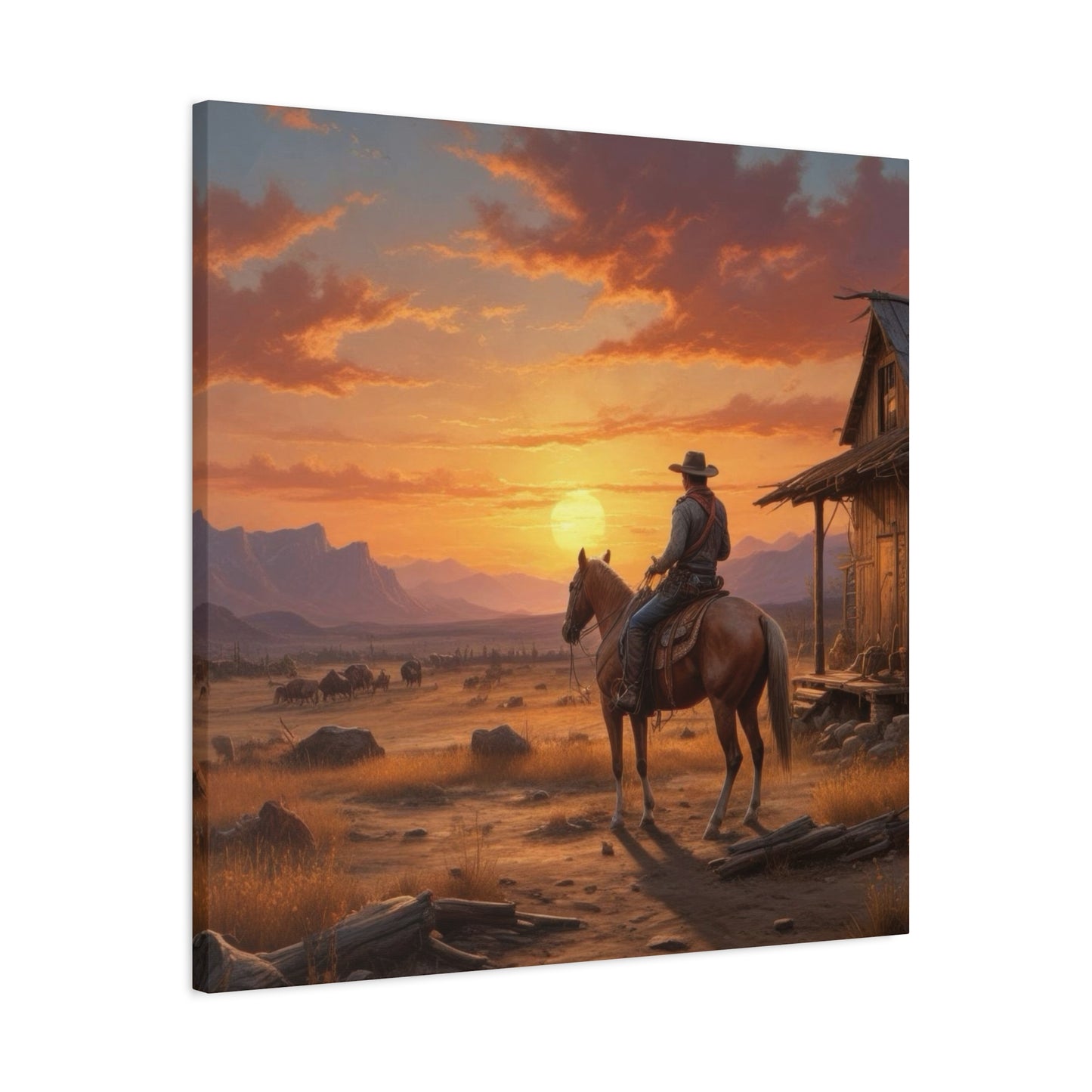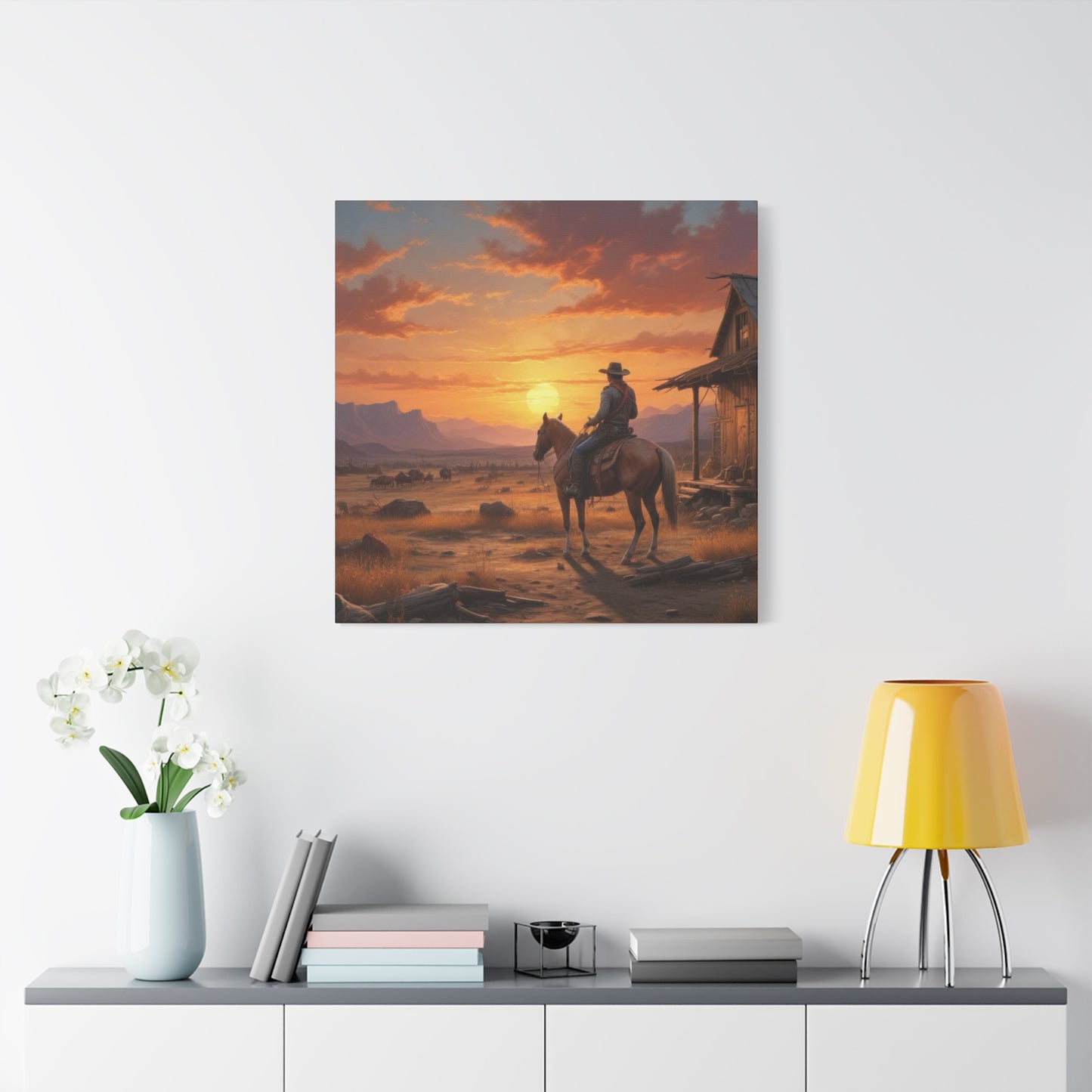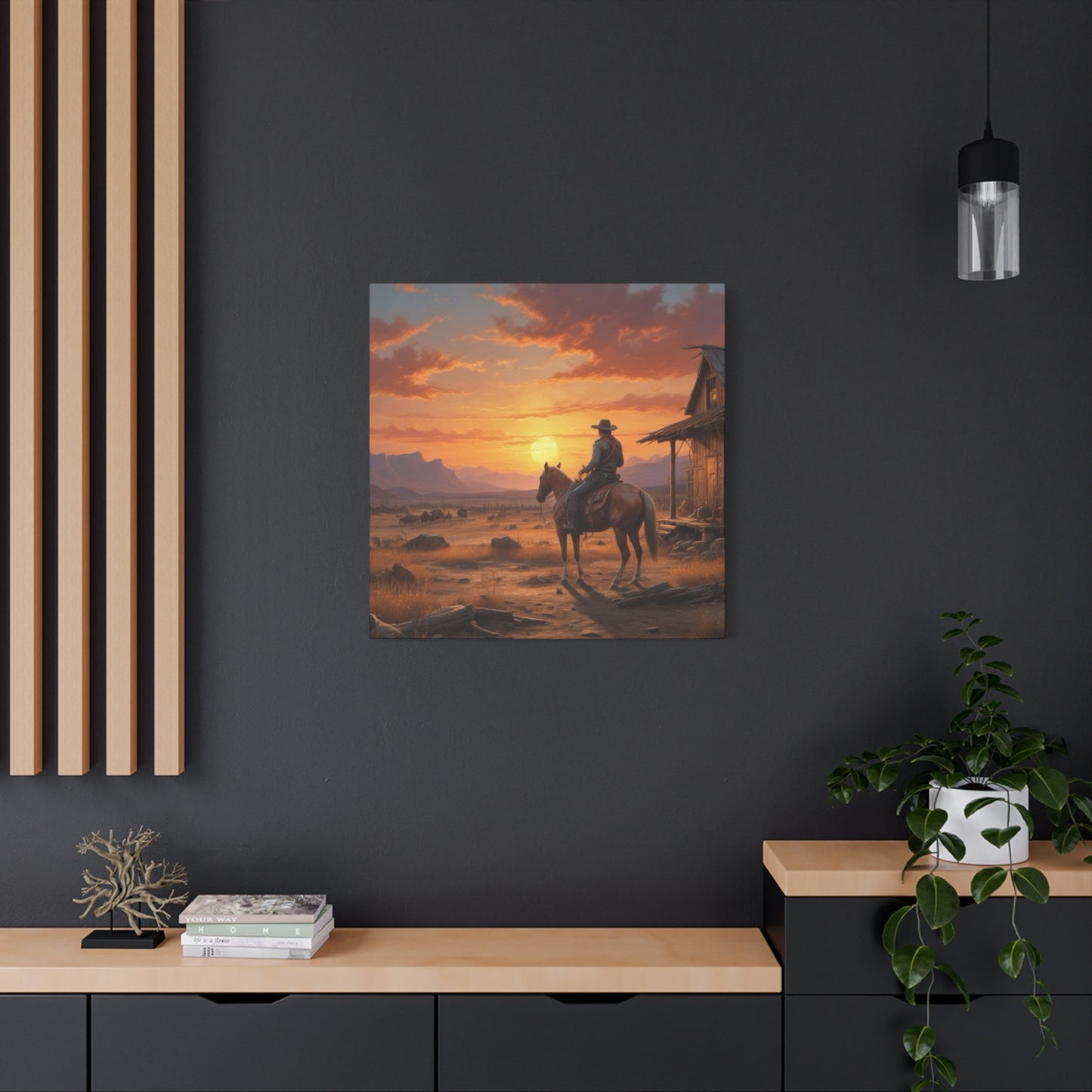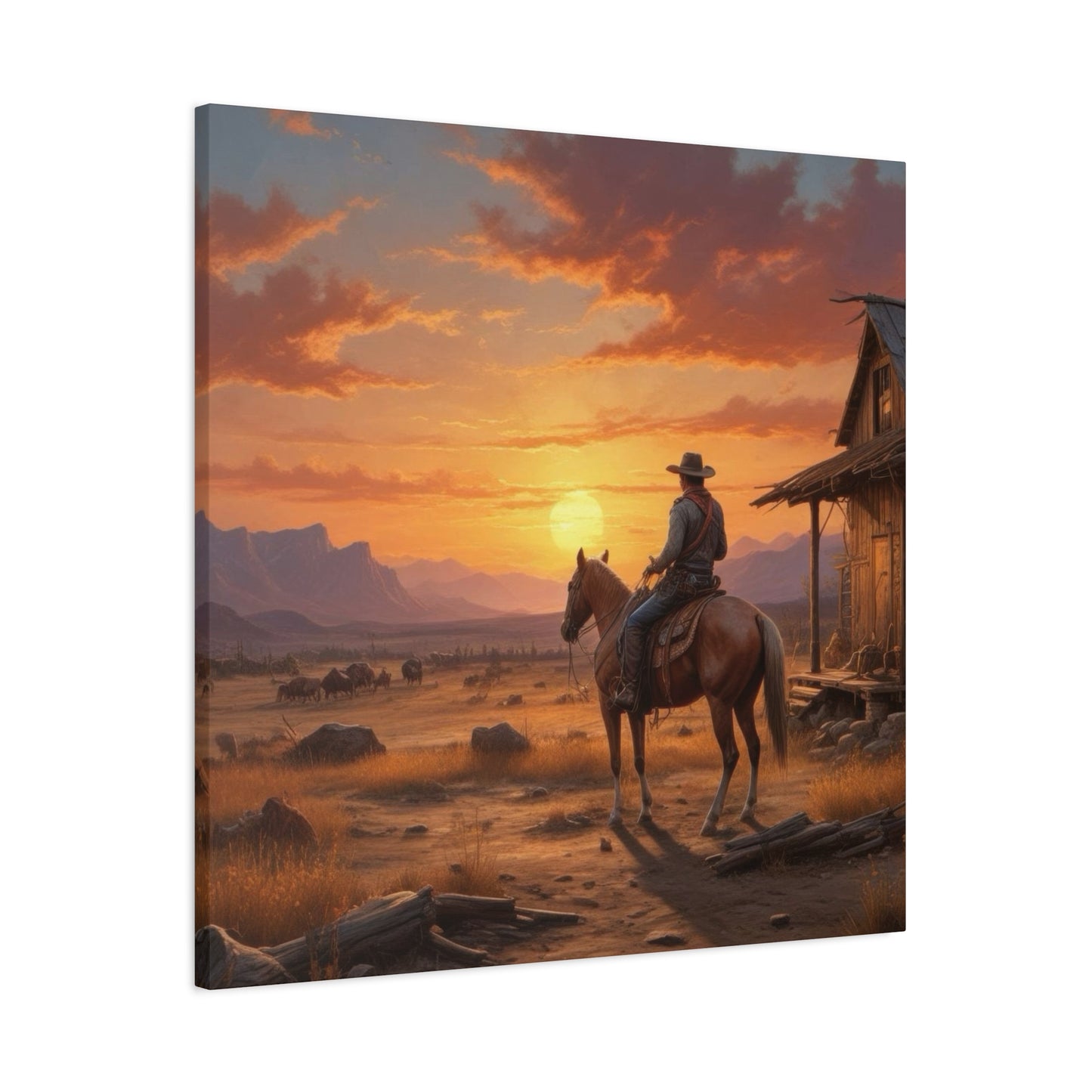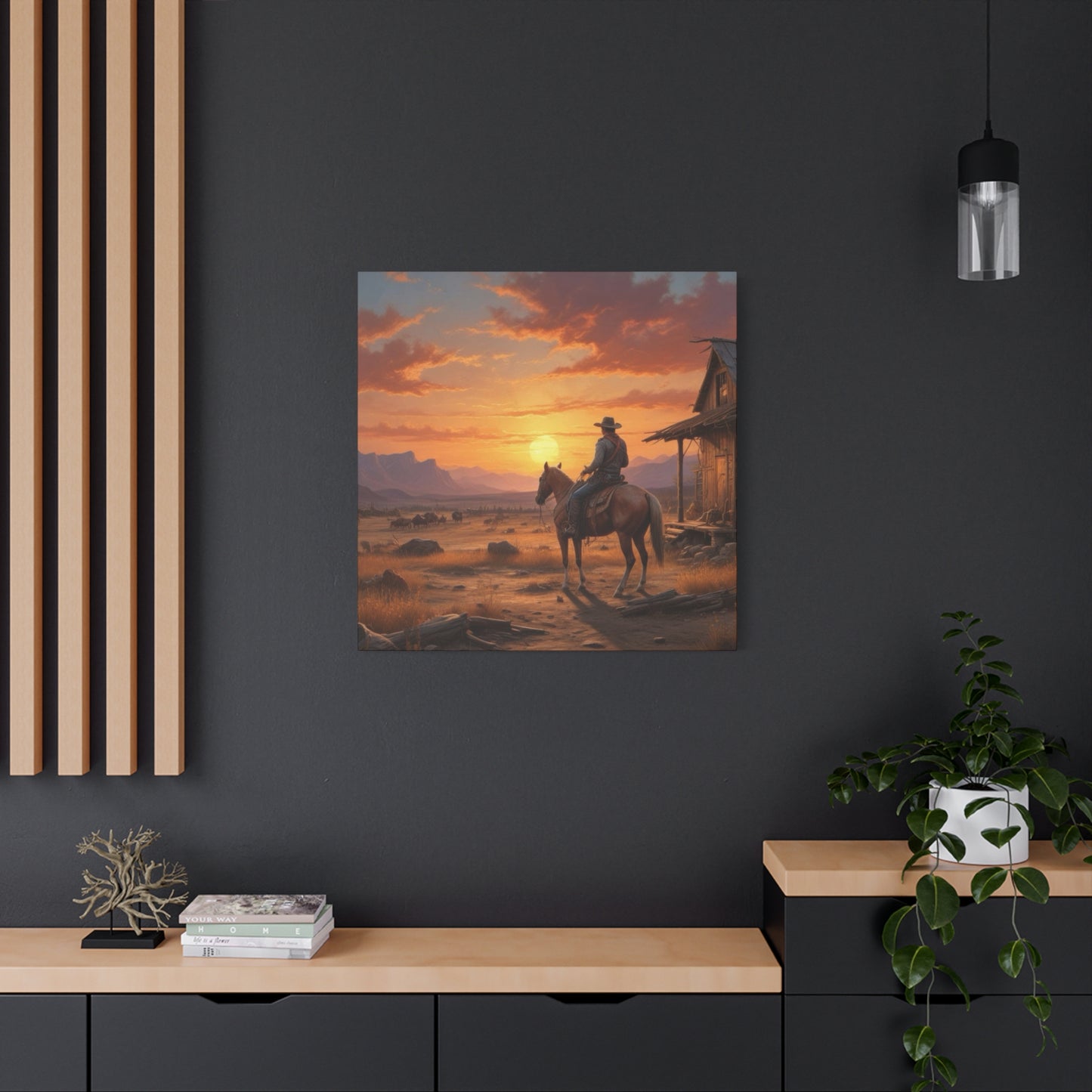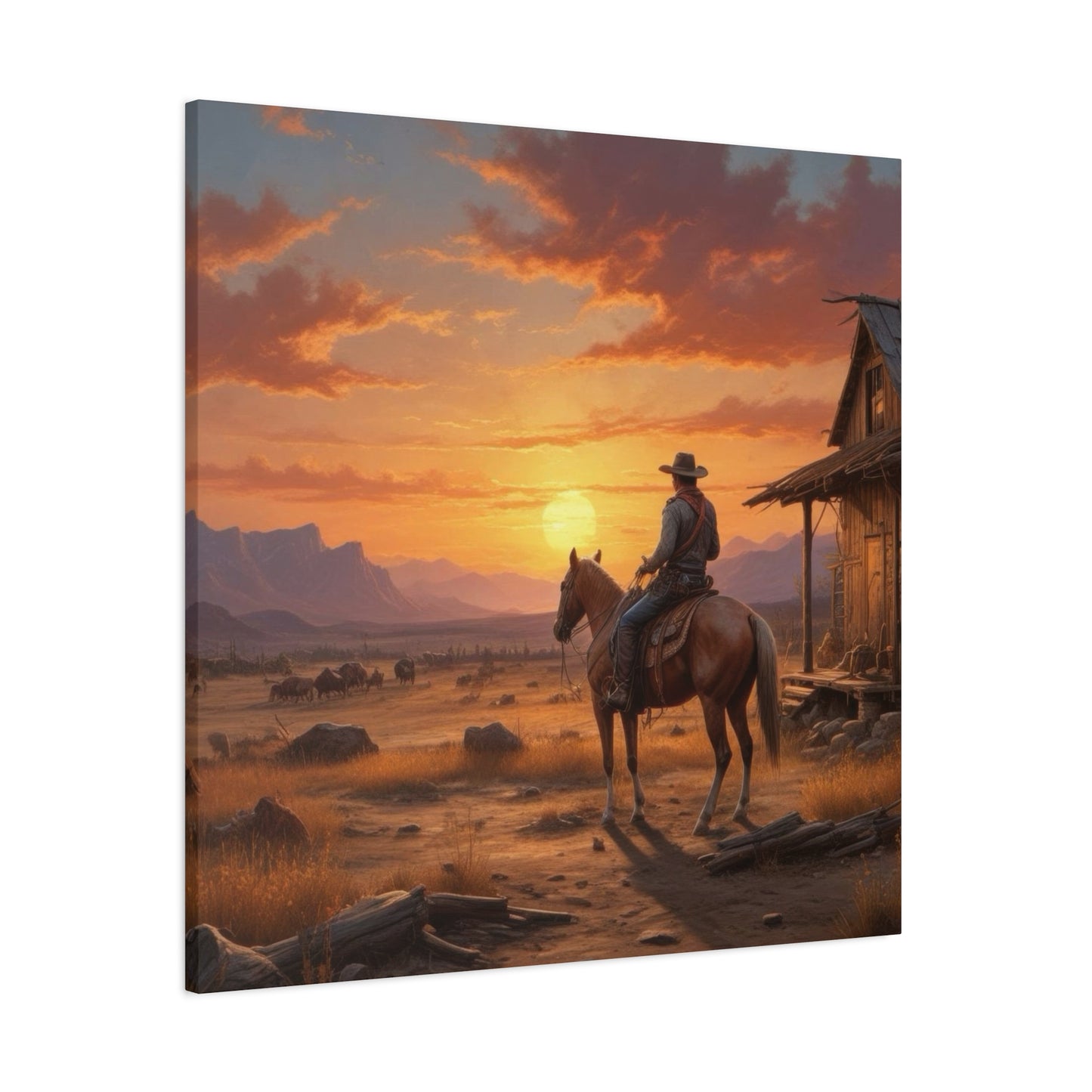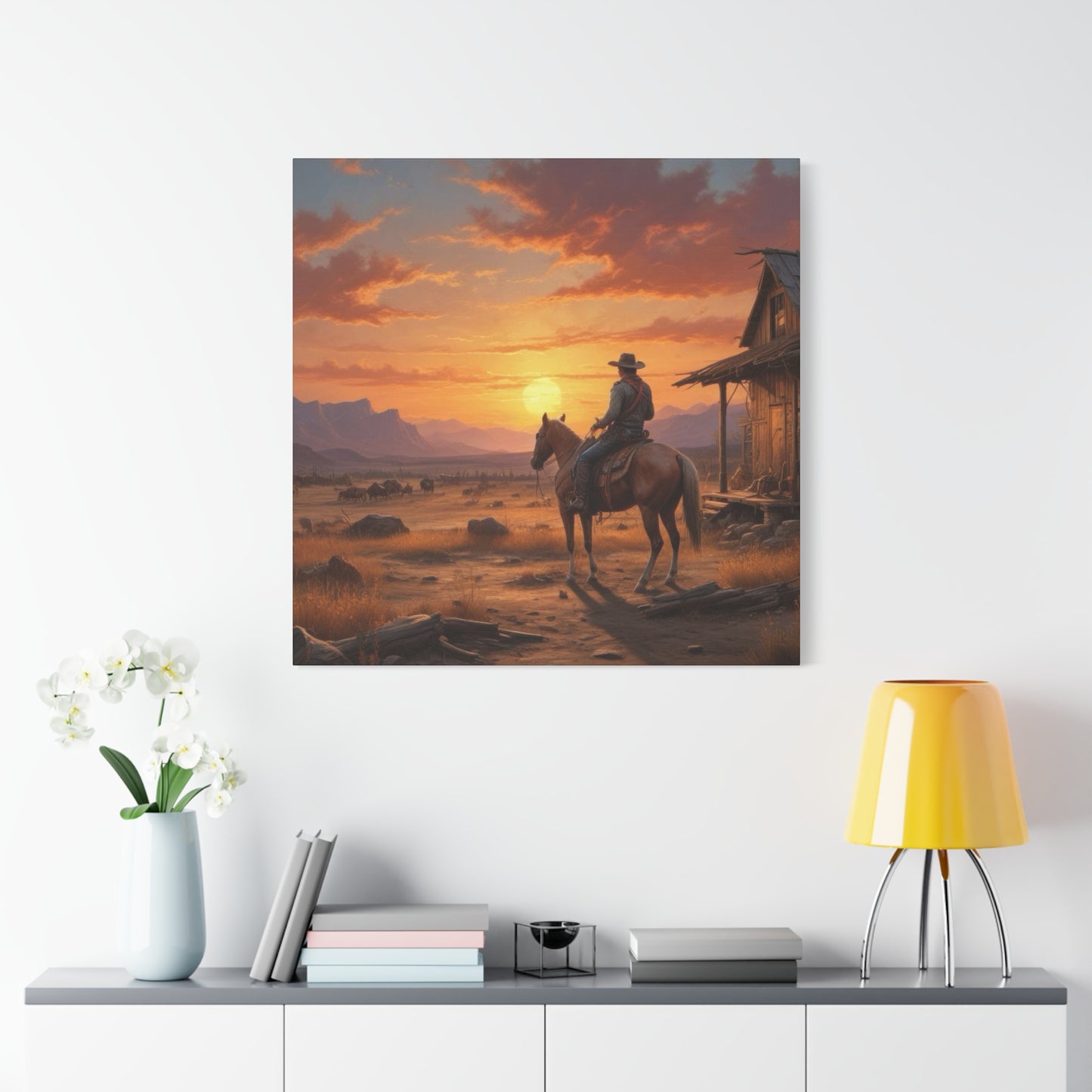Golden Hour in the West: Cowboy at Sunset Wall Art That Blends Adventure and Serenity
The allure of western imagery combined with breathtaking sunset scenes has captivated art enthusiasts and interior designers for generations. When a solitary rider on horseback is silhouetted against a fiery sky, it creates an emotional connection that transcends mere decoration. This comprehensive exploration delves into every aspect of western canvas art featuring cowboys at sunset, from aesthetic principles to practical placement strategies, ensuring you understand why these pieces have become timeless additions to modern living spaces.
Western art represents more than visual appeal. It embodies the spirit of freedom, the romance of open landscapes, and the enduring legacy of frontier life. When sunset colors illuminate these scenes, they add layers of warmth, nostalgia, and dramatic visual impact that few other art styles can match. Whether you're furnishing a ranch-style home, adding character to a contemporary apartment, or seeking that perfect statement piece for your office, understanding the nuances of cowboy sunset canvas art will help you make informed decisions that enhance your environment for years to come.
Iconic Western Canvas Art Depicting Cowboys During Golden Hour
The technical execution of these artworks requires considerable skill. Artists must balance the dramatic sky with the landscape below, ensuring neither element overwhelms the other. The cowboy figure typically appears in silhouette or partial shadow, which allows viewers to project their own narratives onto the scene. This ambiguity is intentional and contributes to the universal appeal of these compositions. Whether the rider is heading home after a long day, beginning a journey into the unknown, or simply pausing to appreciate the natural beauty surrounding them, the interpretation remains open and personal.
Canvas printing technology has revolutionized how these western scenes reach consumers. High-quality reproductions now capture the subtle gradations of sunset colors with remarkable fidelity, from the deepest purples and blues near the horizon to the brilliant oranges and reds that dominate the upper atmosphere. Gallery-wrapped canvases eliminate the need for traditional framing, creating a contemporary presentation that suits modern interiors while respecting the classic subject matter. The texture of canvas adds tactile interest that paper prints cannot provide, creating shadows and highlights that change as lighting conditions in your room shift throughout the day.
Collectors and decorators appreciate how western sunset canvas art bridges traditional and contemporary aesthetics. The subject matter appeals to those with connections to rural lifestyles or appreciation for American history, while the artistic treatment and presentation methods align with current design trends. This versatility explains why these pieces appear equally at home in rustic cabins, urban lofts, corporate offices, and suburban family rooms. The emotional resonance transcends demographic boundaries, speaking to fundamental human experiences of solitude, natural beauty, and the passage of time.
Majestic Sunset Scenes Featuring Lone Cowboys
Loneliness and independence are two sides of the same coin in western mythology, and nowhere is this duality more powerfully expressed than in artwork featuring solitary cowboys against sunset backdrops. These compositions tap into archetypal imagery that resonates across cultures and generations. The lone rider represents self-reliance, courage, and the willingness to forge one's own path, while the magnificent sunset reminds viewers of nature's grandeur and the fleeting nature of each day's beauty.
Artists working in this genre carefully consider composition elements to maximize emotional impact. The placement of the cowboy figure within the frame determines the narrative emphasis. A centered subject creates balance and stability, suggesting confidence and control. An off-center placement, following the rule of thirds, introduces dynamic tension and implies movement through space. The horse and rider might be positioned facing into the frame, suggesting forward progress toward unknown destinations, or facing outward, creating a sense of departure or nostalgia for what's being left behind.
The sky itself becomes a character in these compositions. Clouds catch and scatter light, creating layered bands of color that range from soft pastels to intense, saturated hues. Some artists favor realistic approaches, carefully observing atmospheric phenomena to create scientifically accurate yet emotionally powerful skies. Others embrace more interpretive styles, exaggerating colors and contrasts to heighten dramatic effect. Both approaches have merit and appeal to different aesthetic sensibilities, but all successful examples share a commitment to creating skies that feel alive and dynamic rather than static backdrops.
Ground elements in these compositions serve important supporting roles. The landscape might feature rolling plains that extend to distant horizons, suggesting endless possibilities and freedom. Rocky outcroppings or desert terrain add textural variety and speak to the harsh beauty of western environments. Sparse vegetation, whether scrubby bushes or the distinctive silhouettes of saguaro cacti, reinforces the sense of place without cluttering the composition. Some pieces include subtle details like distant mountains or the suggestion of a winding trail, adding depth and inviting viewers to explore the scene visually.
Capturing Western Adventure on Canvas
Adventure permeates every aspect of cowboy culture, from historical cattle drives to modern rodeo competitions. Canvas art that captures this adventurous spirit connects with viewers on a primal level, awakening desires for exploration and experiences beyond the routine of daily life. When combined with sunset imagery, these adventure narratives gain additional layers of meaning, as endings and beginnings merge in the transitional light of day's conclusion.
The concept of adventure in western art extends beyond obvious action scenes. A lone rider crossing a vast plain embodies adventure through suggestion rather than explicit action. The viewer understands that this figure has likely traveled far and faces continued challenges ahead. The sunset setting implies that camping under stars awaits, that navigation by natural landmarks will soon be necessary, that the day's work is ending but tomorrow will bring new experiences. These implied narratives engage the imagination in ways that more literal representations might not.
Canvas prints depicting western adventures during sunset often incorporate elements that suggest the relationship between human and environment. Dust clouds raised by moving horses catch and scatter the angled sunlight, creating atmospheric effects that add depth and realism. The elongated shadows of late afternoon stretch across the landscape, creating visual patterns that lead the eye through the composition. Birds might appear in flight, heading to roost as night approaches, or cattle might be visible in the distance, completing the day's grazing. These details situate the cowboy within a living ecosystem rather than presenting them as isolated from their environment.
The emotional tone of adventure-themed western canvas art varies considerably based on artistic choices. Some pieces emphasize the romantic aspects of frontier life, presenting idealized visions of freedom and independence that may not fully acknowledge historical hardships. Others adopt more realistic or even gritty approaches, showing signs of wear on equipment, fatigue in the rider's posture, or challenging terrain that must be navigated. Both approaches have audience appeal, and choosing between them often depends on whether you want your space to evoke escapist fantasy or grounded appreciation for the actual challenges of western lifestyles.
Color palettes in adventure-focused western sunset art tend toward warm tones that reinforce the excitement and energy of exploration. Oranges, reds, and yellows dominate the sky, creating vibrant backgrounds that energize spaces. These warm tones psychologically stimulate and activate viewers, making such pieces excellent choices for areas where you want to maintain alertness and engagement. Home offices, exercise rooms, or creative studios benefit from the subtle psychological boost these warm color schemes provide.
Vibrant Skies and Cowboy Silhouettes in Wall Art
The dramatic contrast between luminous skies and darkened figures creates some of the most visually arresting imagery in western canvas art. Silhouettes strip away surface details, reducing subjects to their essential forms and allowing pure shape and gesture to communicate narrative and emotion. When combined with the spectacular color displays of sunset skies, these simplified figures become powerful symbols that transcend specific individuals to represent universal archetypes.
Silhouette techniques in western art carry significant advantages for both artists and viewers. For artists, silhouettes eliminate the need for detailed facial features, clothing textures, or other specifics that might date the piece or limit its appeal. The cowboy becomes an everyman figure, representing not a particular individual but the entire tradition and lifestyle. For viewers, this abstraction invites personal projection. You might see yourself as that solitary rider, or remember someone from your own life, or simply appreciate the universal symbolism without needing specific narrative details.
The sky in silhouette-focused western canvas art must work harder to carry the composition's visual interest. Without detailed foreground elements to examine, viewers spend more time engaging with the colors, patterns, and atmospheric effects of the sunset itself. Artists exploit this by creating particularly dramatic and varied skies, perhaps incorporating unusual cloud formations, complex color gradations, or other eye-catching elements. The result is artwork that rewards extended viewing, revealing new details and color relationships upon each examination.
Technical execution of silhouetted cowboy art requires careful attention to shape design. The outline of the horse and rider must be immediately recognizable and visually interesting despite the lack of interior detail. Hat brims, the horse's ears, the rider's posture, and any visible equipment all contribute to creating distinctive silhouettes that read clearly from across a room. The best examples achieve iconic status, becoming so recognizable that even small versions remain impactful and clear.
Lighting dynamics in these compositions follow natural principles while often embracing artistic enhancement. During actual sunsets, backlighting creates the silhouette effect as the bright sky overwhelms reflected light from objects in the foreground. Artists may exaggerate this effect for dramatic purposes, creating absolutely solid blacks that contrast with luminous skies, or they might include subtle color tints in the shadowed areas, suggesting reflected light from the sky that adds visual interest without breaking the silhouette's integrity.
Rustic Western Canvas Prints for Living Rooms
Living rooms serve as primary gathering spaces where families relax, entertain guests, and spend substantial time. The artwork chosen for these areas significantly impacts the room's atmosphere and the impressions visitors form about the home and its occupants. Rustic western canvas prints featuring cowboys at sunset offer warmth, character, and conversation-starting visual interest that more generic artwork cannot provide.
The term rustic encompasses various aesthetic approaches, from weathered and aged appearances to natural materials and earth-toned color schemes. Western sunset canvas art naturally aligns with rustic sensibilities through its subject matter and typical color palettes. The warm oranges, browns, and golds of sunset skies complement wooden furniture, leather upholstery, and stone accents common in rustic interior design. Even in spaces that aren't fully committed to rustic styling, a western sunset canvas can introduce natural warmth that softens more contemporary or minimalist approaches.
Scale considerations become particularly important in living room installations. These spaces typically feature longer sight lines than bedrooms or offices, allowing for larger artworks that might overwhelm more intimate areas. A substantial canvas print above a sofa or fireplace creates an authoritative focal point that anchors the room's design scheme. The expansive landscapes typical of western sunset scenes benefit from generous sizing, as reducing them to small dimensions can make details difficult to appreciate and diminish their emotional impact.
Placement options in living rooms extend beyond the obvious above-the-sofa position. A large western sunset canvas can command attention on any prominent wall, whether flanked by windows, positioned above a console table, or standing alone as a gallery-style installation. In open-concept spaces, strategic artwork placement helps define distinct zones without requiring physical barriers. A commanding cowboy sunset print above a seating area clearly marks that space as the conversation zone, while other areas might be defined through different artwork or design elements.
The social dynamics of living rooms influence artwork selection differently than private spaces. While bedroom art primarily needs to satisfy personal preferences, living room pieces should appeal to a broader audience, including family members and guests. Western sunset imagery has broad demographic appeal, avoiding the narrow taste constraints of more specific genres or styles. Most viewers respond positively to beautiful natural scenes, and the addition of the cowboy figure adds narrative interest without introducing controversial or polarizing elements.
Lighting considerations significantly impact how western sunset canvas art appears in living room settings. These spaces typically incorporate multiple light sources, from natural daylight to overhead fixtures, table lamps, and possibly accent lighting. The warm tones in sunset-themed art interact beautifully with incandescent or warm LED lighting, which enhances oranges and reds while softening blues and purples. Natural daylight creates different effects throughout the day, potentially making the canvas appear cooler in morning light and warmer in afternoon sun. Understanding these variations helps in positioning artwork to appear most attractive during the hours when the room sees heaviest use.
Sunset-Inspired Wall Art for Cozy Interiors
Coziness represents an emotional quality rather than a specific design style, though certain elements contribute reliably to creating cozy atmospheres. Warm colors, soft textures, appropriate lighting, and personal touches combine to make spaces feel welcoming and comfortable. Sunset-inspired western canvas art contributes to coziness through its inherent warmth, both in color temperature and emotional resonance, making it an excellent choice for spaces intended to feel like refuges from the outside world.
The psychological effects of color temperature significantly impact perceived coziness. Warm hues like reds, oranges, and yellows psychologically register as inviting and comfortable, while cool blues and greens often feel more formal or energizing. Sunset scenes naturally emphasize warm tones, making them ideal for spaces where relaxation is the primary goal. The gradual transition from bright warm tones near the horizon to cooler purples and blues higher in the sky creates visual complexity while maintaining overall warmth, preventing the monotony that might result from entirely uniform color schemes.
Sunset-themed western art contributes to cozy interiors through its inherent nostalgia and romanticism. These qualities aren't universal but are widely shared responses to frontier imagery and spectacular natural phenomena. The emotional resonance of watching day transition to night, of imagining simpler times and lifestyles, of connecting with traditional American cultural narratives, all combine to create feelings of comfort and security. This emotional dimension transcends mere visual decoration, making the artwork a genuine contributor to the room's psychological atmosphere.
Layering is essential to achieving genuinely cozy interiors, and artwork functions as one layer among many. A sunset western canvas might share wall space with family photographs, decorative shelves displaying personal collections, or other meaningful objects. This layered approach prevents the sterile, show-home appearance that results from treating walls as simply backgrounds for single statement pieces. The canvas becomes part of a visual story about who lives in the space and what they value, contributing to authenticity that is fundamental to true coziness.
Lighting design significantly impacts how sunset artwork contributes to cozy atmospheres. Harsh overhead lighting can make spaces feel institutional rather than comfortable, regardless of furnishings or artwork. Instead, multiple softer light sources at varying heights create pools of illumination separated by gentler shadowed areas. This varied lighting makes rooms feel more intimate and comfortable while also creating changing views of your western sunset canvas as different lights are activated throughout evening hours. Some homeowners install picture lights above significant artworks, ensuring they remain visible focal points even in overall dimmer lighting conditions.
Cowboy at Sunset Bold Statement Canvas Art
Statement pieces serve specific decorative purposes, commanding attention and establishing visual hierarchies within spaces. Bold statement canvas art featuring cowboys at sunset achieves this through size, color intensity, dramatic composition, or all three combined. These pieces aren't meant to blend quietly into backgrounds but rather to announce themselves confidently and shape how the entire space is perceived and experienced.
Boldness in western canvas art can manifest through various channels. Physical size represents the most obvious approach, with oversized prints creating undeniable impact through sheer presence. A six-foot-wide canvas depicting a cowboy against a spectacular sunset sky immediately establishes itself as the room's focal point, demanding acknowledgment from anyone entering the space. This scale works particularly well in rooms with high ceilings or expansive wall surfaces, where proportionally sized artwork prevents spaces from feeling empty or unfinished.
Color intensity provides another path to bold statement impact. While some sunset scenes employ subtle, naturalistic palettes, others embrace highly saturated, almost surreal color schemes that push beyond realism into pure visual drama. These intensified palettes create artwork that vibrates with energy, drawing eyes irresistibly and energizing entire spaces through color radiation effects. Such bold approaches work especially well in contemporary settings where dramatic visual moments are valued over subtle refinement.
Compositional drama creates bold statements through unexpected arrangements, unusual perspectives, or dynamic action rather than static poses. A cowboy might appear in extreme foreground while the sunset dominates the background, creating dramatic scale contrasts. The horizon line might be positioned very low or high in the frame, challenging conventional landscape expectations. Multiple subjects might be arranged to create tension or narrative complexity. These compositional choices make familiar subject matter feel fresh and engaging, ensuring your statement piece maintains interest over time.
The relationship between bold statement artwork and surrounding elements requires careful consideration. A powerful canvas can either complement or clash with existing furnishings and decorations depending on how well the overall scheme is orchestrated. Bold doesn't necessarily mean discordant; many successful interiors feature dramatic artwork that nonetheless coordinates beautifully with more subdued surrounding elements. The key lies in identifying unifying factors, whether shared color notes, tonal relationships, or stylistic connections that tie disparate elements into coherent wholes.
Statement pieces naturally draw focus, making them excellent tools for addressing architectural challenges. An awkwardly proportioned wall, an off-center fireplace, or other design irregularities can be de-emphasized by installing commanding artwork that redirects attention. The viewer's eye goes to the powerful western sunset canvas rather than analyzing the room's structural quirks. This strategic use of art to solve spatial problems demonstrates sophistication in interior design thinking beyond mere decoration.
Evoking Freedom and Adventure Through Western Art
Freedom represents perhaps the central theme in western cultural mythology, and no artistic genre captures this concept more powerfully than images of cowboys in vast open landscapes. When these scenes are set during sunset's golden hour, the symbolism deepens, as the day's freedom gives way to night's mysteries and possibilities. Western canvas art that successfully evokes freedom and adventure connects with fundamental human desires for autonomy, self-determination, and escape from routine constraints.
The visual language of freedom in western art relies heavily on spatial relationships. Expansive landscapes with visible horizons communicate unlimited possibilities and absence of confinement. The lone cowboy's small scale relative to the surrounding environment emphasizes human insignificance before nature while simultaneously celebrating the courage required to venture into such vastness. This paradox of being both humbled and empowered by wilderness experiences forms the emotional core of the most compelling western art.
Adventure differs from simple freedom in its active, forward-looking orientation. While freedom might be experienced in peaceful solitude, adventure implies journey, challenge, and the pursuit of experiences beyond the familiar. Western sunset canvas art suggesting adventure typically includes visual elements indicating movement or purpose. The horse might be positioned mid-stride, dust rising from hooves. The rider's posture might lean forward, suggesting urgency or determination. The direction they face within the frame might lead toward unknown spaces beyond the canvas edge, inviting viewers to imagine what lies ahead.
Historical context enriches how contemporary viewers interpret freedom and adventure themes in western art. The American frontier represented literal freedom for some, opportunity for others, and displacement for Indigenous peoples. Modern western art exists in conversation with these complex histories, and thoughtful pieces acknowledge this complexity rather than offering simplistic romanticizations. The best contemporary western artists balance appreciation for frontier aesthetics and mythology with awareness of historical realities, creating artwork that honors the past without distorting it.
Personal projection plays a significant role in how western art evokes freedom and adventure. Viewers bring their own desires, experiences, and dreams to their interpretation of these scenes. Someone trapped in urban routine might see the cowboy as representing escape and simpler living. An entrepreneur might interpret the image as celebrating independence and risk-taking. Someone grieving might find comfort in the natural cycle suggested by the sunset, while someone embarking on new chapters sees the image as affirmation of their courage. This interpretive flexibility makes western sunset art universally appealing despite its culturally specific imagery.
Warm Sunset Hues in Cowboy Wall Décor
Color temperature profoundly influences spatial perception and emotional response, making it a critical consideration in interior design. Warm sunset hues, ranging from golden yellows through oranges and reds to warm purples, create inviting, energizing environments that feel fundamentally welcoming. Western canvas art emphasizing these warm color ranges brings natural beauty indoors while providing psychological benefits that cool-toned artwork cannot match.
The science of color perception explains why warm sunset hues affect us so powerfully. Human vision evolved to interpret warm light as indication of fire, sunshine, and other sources of heat and safety. Cool light, conversely, suggests nighttime, distance, or shade. These ancient associations persist in our modern psychology, making warm-colored environments feel inherently more comfortable and secure. Western sunset canvas art leverages these innate responses, creating instant emotional impact through color selection alone, before subject matter or composition even register consciously.
Different sunset hues create distinct atmospheric effects. Golden hour light, appearing when the sun hovers just above the horizon, bathes everything in warm yellow tones that feel optimistic and gentle. As the sun descends further, oranges intensify, adding energy and vibrancy to the palette. Deep reds emerge as the sun nears the horizon, introducing drama and intensity. Finally, purples and magentas dominate the sky after the sun dips below sight lines, these cooler warm tones creating mysterious, romantic atmospheres. Western canvas art might emphasize any point in this progression, each creating different emotional tones.
Coordinating warm sunset canvas art with room color schemes requires understanding color relationships and harmonies. Analogous color schemes, using colors adjacent on the color wheel, create cohesive, sophisticated appearances. A canvas featuring orange and red sunset tones might coordinate beautifully with warm brown or tan wall colors, creating harmonious warmth throughout the space. Complementary color schemes, using opposite color wheel positions, create higher energy and more dynamic results. Blue accent pieces might be strategically placed in a room featuring predominantly warm sunset artwork, the cool-warm contrast adding visual excitement and preventing monotony.
The intensity or saturation of sunset hues significantly impacts artwork's effectiveness in different settings. Highly saturated, vivid colors create bold, contemporary feels appropriate for modern spaces seeking visual impact. Desaturated or muted warm tones, while still reading as warm overall, create softer, more traditional or romantic atmospheres. Some western sunset canvas prints offer compromise approaches, featuring intense color in sky areas while employing more subdued tones in landscape elements, balancing visual excitement with restraint.
Layered Landscapes and Dramatic Sky Canvas Prints
Depth and dimensionality separate compelling landscape art from flat, uninteresting renditions. Layered landscapes achieve three-dimensional illusion through carefully orchestrated recession planes, atmospheric perspective, and scale relationships. When combined with dramatic skies that command attention through color, pattern, or atmospheric effects, the result is canvas art that draws viewers into immersive visual experiences rather than simply presenting them with decorative surfaces.
Atmospheric perspective, also called aerial perspective, provides the primary tool for creating depth in landscape art. This optical phenomenon, caused by light scattering through atmosphere, makes distant objects appear lighter, bluer, and less distinct than near objects. Skilled western artists exploit this effect, rendering foreground elements in sharp detail with warm tones and strong contrasts, while progressively lightening and cooling colors for mid-ground and background features. The cowboy figure might appear in crisp silhouette against the sunset, while distant mountains fade to soft blue-gray shapes barely distinguishing themselves from the sky.
Overlapping forms create another powerful depth cue. When one object partially obscures another, viewers automatically understand the visible object as nearer. Western sunset compositions might show a cowboy in foreground, partially concealing middle-ground terrain features like rock formations or shrubs, which in turn overlap distant mountains or clouds. These overlapping relationships guide the eye through the composition's spatial layers, creating journey through painted space that adds temporal dimension to the viewing experience. You don't simply see the entire image at once; you progressively discover and explore its spatial relationships.
Scale relationships reinforce depth perception through size gradients. Objects appear smaller as distance increases, a phenomenon western artists use extensively. A foreground cactus might dominate lower frame areas, its substantial size clearly indicating proximity. Mid-ground vegetation appears progressively smaller, while distant trees or structures become tiny markers on the horizon. The cowboy figure's size relative to these elements places them specifically within the spatial construction, allowing viewers to gauge distances and scale relationships even without precise measurement.
Dramatic skies in western canvas art often feature complex cloud formations that create their own layered depths. Clouds at different altitudes catch and reflect light differently, creating bands of varying color and brightness. Lower clouds might appear as dark silhouettes against brighter sky, while high altitude clouds remain illuminated long after the sun has set below the horizon. These layered atmospheric effects add visual complexity and realism while reinforcing the sense of vast three-dimensional space extending upward as well as across the landscape.
Light and shadow patterns create additional layering opportunities. As the setting sun moves toward the horizon, its angled rays create long shadows that stretch across terrain, visually connecting foreground and background elements. These shadows might darken ravines while leaving ridges illuminated, creating alternating bands of light and dark that guide the eye through compositional space. The cowboy figure casts its own shadow, perhaps extending toward the viewer or across adjacent ground, further integrating the subject with their environment.
Western-Themed Canvas Art for Bedrooms and Offices
Bedrooms and offices serve fundamentally different purposes, requiring distinct approaches to artwork selection despite potentially working with similar western sunset imagery. Understanding how environment affects psychological state and productivity helps in choosing pieces that enhance rather than conflict with each space's intended function. Western canvas art's versatility allows it to serve both contexts effectively when selections account for these functional differences.
Bedroom artwork should promote relaxation, comfort, and positive emotional states conducive to rest and intimacy. Western sunset scenes naturally support these goals through warm color palettes that create cozy atmospheres and contemplative imagery that encourages mental unwinding. Bedrooms benefit from artwork that feels personal and meaningful rather than generic or purely decorative. A cowboy sunset canvas resonating with your values, memories, or aspirations creates emotional connection that makes the space truly yours rather than simply decorated.
The viewing context differs significantly between bedrooms and other spaces. Much bedroom artwork viewing occurs from bed, meaning pieces above headboards or on opposing walls are seen primarily from reclining or semi-reclined positions. This affects optimal artwork height and composition orientation. Horizontal compositions often work better than vertical ones for viewing from bed, as they align with the natural horizontal viewing angle. Subject matter appearing higher in the frame might be difficult to see when reclined, suggesting compositions where primary interest occupies central or lower frame areas.
Office environments demand different considerations. Whether home offices or corporate spaces, these areas should promote focus, creativity, and professional atmosphere. Western sunset canvas art succeeds in offices by providing visual breaks that prevent mental fatigue while maintaining appropriate sophistication. The balance between relaxation and stimulation becomes crucial. Artwork should be engaging enough to provide mental refreshment during brief glances but not so distracting that it pulls attention away from work tasks.
Color psychology plays different roles in bedrooms versus offices. Bedroom palettes should emphasize relaxation, making softer, more muted sunset tones often preferable to highly saturated, energetic colors. An office might benefit from more vibrant hues that maintain alertness and energy throughout work sessions. However, individual responses vary significantly, and some people find energetic colors in bedrooms motivating for morning routines, while others prefer calmer office environments. Understanding your personal responses to color helps in making selections that genuinely enhance your daily experience rather than following generic guidelines that may not match your needs.
Cowboy Silhouettes Against Golden Sunset Skies
Golden hour light, occurring briefly before sunset, creates particularly magical conditions for western imagery. During this period, sunlight takes on warm, honeyed quality that flatters virtually every subject while creating long, dramatic shadows. Cowboy silhouettes photographed or painted during golden hour capture this special light's romance and beauty, making them among the most emotionally resonant variations within western canvas art.
The specific color qualities of golden hour light distinguish it from other sunset phases. While later sunset stages feature more dramatic reds and purples, golden hour emphasizes yellows, warm oranges, and soft peachy tones that feel gentle rather than intense. This softer warmth creates approachable, comfortable artwork that works in wider range of settings than more dramatically colored pieces. The golden palette coordinates beautifully with natural materials like wood, stone, and leather, making it ideal for both rustic and contemporary interiors that incorporate these elements.
Silhouettes benefit particularly from golden hour treatment because the bright background creates clean, crisp figure outlines without the haziness that can occur in more complex lighting situations. The cowboy and horse read as perfectly defined shapes, their iconic forms immediately recognizable even at small scales or from significant distances. This clarity ensures the artwork communicates effectively whether viewed up close or from across a room, an important consideration for larger spaces or pieces intended as focal points from multiple viewing positions.
The emotional tone of golden hour cowboy silhouettes tends toward nostalgic and romantic rather than dramatic or intense. These pieces evoke wistfulness, gentle longing, and appreciation for simple beauty. They suggest peaceful conclusions to productive days, satisfaction in work completed, and quiet contentment with one's place in the world. This emotional character makes golden hour silhouettes particularly appropriate for spaces dedicated to reflection and relaxation, though they can also provide welcome visual respite in more active environments.
Compositional strategies for golden hour silhouettes often emphasize horizontal orientations that showcase the broad, luminous skies characteristic of this lighting condition. The horizon might be positioned low in the frame, dedicating the majority of canvas space to the glowing sky. Alternatively, the horizon might appear mid-frame with significant landscape visible below, allowing the warm light to illuminate ground textures and create additional visual interest beyond the sky alone. Both approaches capitalize on golden hour's unique qualities while creating quite different aesthetic experiences.
Rustic Charm Captured in Sunset Canvas Prints
Rustic aesthetics celebrate natural materials, honest construction, and connections to traditional lifestyles and values. Western sunset canvas prints naturally embody rustic charm through their subject matter, but artistic execution determines whether pieces genuinely capture authentic rustic spirit or merely gesture toward it superficially. Understanding what constitutes genuine rustic character helps in selecting pieces that integrate seamlessly with rustic design schemes while avoiding clichéd or artificial interpretations.
Authentic rustic charm emerges from respect for subject matter rather than exploitation of it. Artists who genuinely understand and appreciate western lifestyles, natural landscapes, and the realities of outdoor life create work that resonates with authenticity. Their compositions reflect actual experiences and observations rather than idealized fantasies disconnected from reality. This authenticity manifests in details like accurate equipment, realistic horse anatomy and behavior, genuine understanding of how light interacts with various landscape elements, and honest portrayal of both beauty and harshness in western environments.
Color palettes contribute significantly to rustic charm. While brilliant, highly saturated colors can appear in sunsets, rustic-oriented artwork often favors slightly muted or earthy tones that coordinate with natural materials and traditional interior palettes. Think warm browns, dusty oranges, sage greens, and weathered blues rather than electric brights. These subdued color choices create harmony with wooden furniture, natural fiber textiles, and other rustic interior elements while maintaining visual interest and appeal.
Texture plays an essential role in rustic aesthetics, both in physical materials and visual representations. Canvas naturally provides beneficial texture through its weave pattern, but artistic technique can enhance this quality. Visible brushwork in painted pieces creates additional textural interest that aligns with rustic appreciation for handcraft and individual artistic touch. Even in photographic or digital artwork, techniques that emphasize natural textures in subjects like weathered wood, rough stone, or the terrain itself contribute to overall rustic character.
The relationship between subject and presentation affects rustic authenticity. Simple, straightforward presentations often work better than elaborate, ornate approaches. Gallery-wrapped canvases without additional framing create clean, honest presentations that let the image speak for itself. If framing is used, simple designs in natural materials like unfinished wood or distressed frames maintain rustic consistency. Overly decorative or formal framing can clash with rustic subject matter, creating disconnect between content and presentation that undermines the overall effect.
Rustic charm doesn't require roughness or lack of sophistication. Some of the most successful rustic interiors balance natural elements with refined execution, creating spaces that feel comfortable and authentic without appearing crude or unfinished. Western sunset canvas art supporting this sophisticated rustic approach combines excellent artistic quality with appropriate subject matter and presentation. The result is work that would be equally at home in an upscale mountain lodge or an urban loft incorporating rustic elements, demonstrating that rustic aesthetic transcends specific locations or literal rural settings.
Timeless Western Scenes for Contemporary Homes
The apparent contradiction between traditional western subject matter and contemporary interior design dissolves upon closer examination. Successful contemporary spaces often incorporate elements that provide warmth, character, and connection to cultural narratives, preventing the sterile coldness that purely minimalist approaches sometimes create. Western sunset canvas art bridges traditional and contemporary aesthetics, offering visual interest and emotional resonance that enhance rather than conflict with modern design principles.
Contemporary design emphasizes clean lines, uncluttered spaces, and careful editing of decorative elements. Each piece must justify its presence through exceptional quality, meaningful contribution to the space, or both. Western sunset canvas art meets these demanding standards by providing powerful focal points that command attention without requiring supporting clutter. A single outstanding piece above a contemporary sofa creates all the visual interest the space needs, demonstrating that contemporary doesn't mean sparse or unwelcoming.
The color palettes typical of sunset western art coordinate surprisingly well with contemporary interiors. Neutral backgrounds popular in modern design, including various grays, whites, and beiges, provide perfect canvases for artwork's color to shine. The warm sunset tones inject vitality and personality into potentially bland color schemes without overwhelming them. This balance between neutral foundation and colorful accent follows established contemporary design principles while avoiding the monotony that can result from excessive neutrality.
Materials common in contemporary interiors like metal, glass, and concrete might seem incompatible with rustic western imagery, but thoughtful combinations create sophisticated contrasts. The organic subject matter of sunset landscapes and cowboy figures provides welcome relief from hard industrial materials, softening spaces while maintaining contemporary edge. This juxtaposition, when executed skillfully, creates dynamic tension that makes both the artwork and surrounding elements more interesting than either would be in isolation.
Framing and presentation methods significantly affect how western art integrates with contemporary spaces. Traditional ornate frames typically clash with contemporary aesthetics, but frameless gallery wraps or minimal floating frames maintain clean contemporary lines while showcasing the artwork effectively. Some contemporary spaces even embrace the canvas edge as design element, selecting pieces where the image wraps around stretcher bars to create dimensional object rather than flat picture.
Sunset Western Art to Elevate Interior Décor
Elevation in decorating context means raising quality, sophistication, and perceived value beyond baseline functionality. Sunset western art elevates interiors by providing visual interest, cultural resonance, and emotional depth that generic decorations cannot match. Understanding how specific artwork characteristics contribute to elevation helps in selecting pieces that genuinely enhance spaces rather than merely filling them.
Artistic quality represents the foundation of elevation. Poorly executed artwork, regardless of subject matter, diminishes rather than elevates surroundings. Quality manifests through compositional skill, color harmony, technical execution, and that ineffable rightness where all elements work together seamlessly. When selecting western sunset canvas art, prioritize pieces demonstrating genuine artistic merit over those chosen solely for matching existing color schemes or filling specific dimensional requirements.
Originality elevates by providing visual experiences unavailable through mass-market generic options. While perfect uniqueness proves impossible in today's interconnected visual culture, artwork demonstrating individual artistic vision stands apart from formulaic productions. Look for pieces with unusual perspectives, unexpected color interpretations, or compositional approaches that distinguish them from countless similar western sunset images. This originality ensures your space feels personally curated rather than predictably decorated according to obvious templates.
Cultural authenticity adds elevation through substance behind beautiful surfaces. Western art rooted in genuine understanding and respect for its subject matter carries weight that superficial treatments lack. Artists who know horses, understand actual cowboy work and lifestyles, or have spent significant time in western landscapes bring authenticity that sophisticated viewers recognize and appreciate. This authenticity elevates artwork beyond mere decoration into meaningful cultural expression worthy of serious consideration.
Emotional resonance elevates art by creating genuine connections between viewers and pieces. Artwork that moves you, makes you think, or consistently brings you joy provides value far beyond its decorative function. When selecting western sunset canvas art, pay attention to your authentic emotional responses rather than intellectual judgments about what should appeal to you. Pieces creating strong positive emotional reactions will continue bringing satisfaction long after trendier choices have lost their appeal.
Installation quality significantly impacts whether artwork elevates or merely occupies space. Proper mounting at appropriate heights, level hanging, and attention to spacing relative to furniture and architectural features all contribute to polished, professional appearances. Careless or sloppy installation undermines even exceptional artwork, making spaces feel unfinished or amateurish. Taking time to install pieces correctly, potentially seeking professional help for particularly large or valuable canvases, ensures your western sunset art delivers its full elevating potential.
Lone Cowboy Portraits for Statement Wall Pieces
Portrait-oriented western art, focusing specifically on the cowboy figure rather than expansive landscapes, creates different opportunities and challenges than broader scenic compositions. These closer, more intimate views emphasize human elements within western narratives, making personal character, emotion, and individual identity more prominent than in distant silhouette treatments. When executed against dramatic sunset backgrounds, lone cowboy portraits become powerful statement pieces that command attention while inviting contemplation.
The balance between figure and background requires careful calibration in portrait-oriented western sunset art. Too much emphasis on the cowboy risks losing the sunset's contribution, reducing it to mere backdrop. Excessive focus on the sky diminishes the human element that gives the composition emotional weight and narrative focus. Successful portraits achieve equilibrium where both elements feel essential and neither could be removed without destroying the image's integrity. This balance ensures the piece functions as unified whole rather than figure simply placed against unrelated background.
Perspective choices dramatically affect portrait impact. Close viewpoints bringing the cowboy figure large within the frame create intimate, personal connections. Viewers feel they're encountering an individual rather than observing from safe distance. These close portraits might show facial features, revealing expression and personality that distant silhouettes deliberately obscure. Mid-range perspectives showing the figure from waist or torso up provide compromise between intimacy and context, including enough environment to establish setting while keeping focus primarily on the individual.
Facial visibility introduces both opportunities and constraints in western cowboy portraits. Visible faces add personality and specificity, making artwork about particular individuals rather than universal archetypes. This specificity can strengthen emotional connections but also limits viewers' ability to project themselves into the image. Some artists prefer partial obscurement, perhaps showing profile silhouettes or shadowed faces under hat brims, maintaining human presence while preserving some ambiguity. These approaches balance specificity with universality, creating portraits that feel personal without becoming too particular.
Equipment and clothing details gain importance in portrait-oriented pieces where viewers can examine them closely. Authentic period-appropriate gear demonstrates artistic knowledge and commitment to accuracy. Well-worn saddles, properly coiled lariats, authentic hat styles, and other details all contribute to believability and respect for subject matter. Conversely, obviously inauthentic or anachronistic elements undermine credibility and mark the artwork as superficial rather than serious interpretation of western themes.
Conclusion
The enduring appeal of western canvas art featuring cowboys at sunset stems from its unique ability to combine natural beauty, cultural symbolism, and universal emotional resonance in visually compelling formats. Throughout this comprehensive exploration, we have examined how these powerful images function across diverse interior environments, from rustic ranch homes to contemporary urban apartments, demonstrating remarkable versatility that transcends specific decorating styles or regional associations.
Western sunset imagery succeeds because it speaks to fundamental human experiences and aspirations. The lone cowboy represents independence, courage, and the timeless appeal of self-determination, while spectacular sunset skies remind us of nature's majesty and the daily cycles that structure existence. This combination of human narrative and natural phenomenon creates artwork that feels both personally meaningful and universally accessible, allowing viewers from vastly different backgrounds to find connection and value in these scenes.
The practical considerations we have discussed, from color coordination and scale selection to placement strategies and lighting design, empower you to make informed decisions that maximize your western sunset canvas art's impact. Understanding how these pieces interact with architectural features, existing furnishings, and spatial characteristics ensures your selections enhance rather than merely occupy your spaces. The technical aspects of canvas printing, framing options, and installation methods all contribute to whether artwork delivers its full potential or falls short through preventable execution problems.
Artistic diversity within western sunset canvas art means options exist for virtually every aesthetic preference and decorating requirement. Whether you favor photographic realism, impressionistic interpretation, bold contemporary styling, or elegant traditional approaches, the genre accommodates your taste while maintaining its essential character. This stylistic range ensures western sunset art remains relevant and appealing across changing design trends and evolving personal preferences.
The emotional and psychological benefits of living with meaningful artwork extend far beyond surface decoration. Western sunset canvas art that genuinely resonates with you provides daily moments of beauty, serves as conversation catalyst with visitors, and contributes to creating environments that feel personally authentic rather than generically decorated. These intangible benefits justify the time and investment required to select pieces thoughtfully rather than making hasty, poorly considered choices.
Quality considerations deserve emphasis in closing thoughts. While numerous inexpensive options flood the market, investing in well-executed artwork with excellent print quality and proper presentation creates far more satisfaction long-term than filling walls quickly with compromised alternatives. The difference between adequate and excellent becomes increasingly apparent over time, as superior pieces maintain their appeal while lesser options reveal their shortcomings through fading, warping, or simple aesthetic inadequacy.
The cultural significance of western imagery carries responsibility for respectful, thoughtful treatment. The best contemporary western art acknowledges complex histories while celebrating genuine beauty and meaningful traditions. Avoiding simplistic romanticization or appropriation of cultures not your own demonstrates sophistication and ethical awareness that enriches your relationship with the artwork. Thoughtful engagement with western art's traditions and meanings adds depth to your appreciation and makes your collecting choices more meaningful.
Installation and presentation deserve final attention as they dramatically affect how even exceptional artwork functions in actual spaces. Careful mounting at appropriate heights, proper lighting that reveals rather than obscures the piece's qualities, and thoughtful integration with surrounding design elements all separate successful installations from missed opportunities. Taking time to install pieces correctly, potentially consulting professionals for particularly valuable or challenging installations, ensures your investment delivers maximum returns in beauty and satisfaction.

















